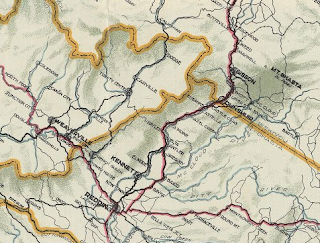As noted above both US Route 97 ("US 97") and California State Route 265 ("CA 265") are aligned on former US 99 within the City of Weed on Weed Boulevard. Approximately 0.430 miles of US 97 is aligned on Weed Boulevard along with 0.435 miles of CA 265. The remaining 0.088 miles of CA 265 are aligned as access to Interstate 5 ("I-5") via Chaparral Drive. Notably; US 97 and CA 265 on Weed Boulevard are also co-signed as Historic US 99 in addition to I-5 Business.
Part 1; the history of highways in the City of Weed
The City of Weed is named after after it's founder Abner Weed. In the 19th Century Abner Weed noted that the winds near the present site of the City of Weed were especially good for drying lumber. In 1897 Abner Weed purchased the Siskiyou Lumber & Mercantile Mill in addition to 280 acres of land where the City of Weed now stands. The community of Weed was plotted along the Central Pacific Railroad Line between the communities of Edgewood and Mount Shasta City. The lumber mill at Weed led to the community growing rapidly during the early 20th Century. In 1961 Weed incorporated as a City.
Thusly US 99 appears on the 1925 Rand McNally Map of California as being plotted on the LRN 3/Pacific Highway in Weed.
The September/October 1951 California Highways & Public Works describes the opening of a new alignment of US 99/LRN 3 from the City of Weed 8 miles south to the vicinity of Mount Shasta City (specifically Spring Hill). This new alignment of US 99/LRN 3 was much straighter than the original highway (built in 1923) and eliminated numerous curves between Weed-Mount Shasta City.
The Federal Aid Highway Act was enacted on June 29th, 1956 which put US 99/LRN 3 through Weed on the planned route of I-5. The November/December 1959 California Highways & Public Works discusses a planned freeway alignment of US 99/LRN 3 north of Weed 3.2 miles to the Shasta River. The then present US 99/LRN 3 on Edgewood Road is described as curvy and difficult to plow in the winter.
The 3.2 miles of US 99/LRN 3 freeway north of downtown Weed replacing Edgewood Road are shown as completed in the January/February 1963 California Highways & Public Works.
Thusly, California Legislative Chapter 1402 was approved by the Governor on July 15th, 1965. Legislative Chapter 1402 extended US 97 south through downtown Weed via Weed Boulevard to the I-5 Highway Avenue Interchange. Legislative Chapter 1402 also created CA 265 which was routed north from US 97 via Weed Boulevard to the North Weed Interchange of I-5.
Despite the changes defined by 1965 Legislative Chapter 1402 I-5 still appears under construction in Weed on the 1966 Division of Highways Map. It is likely US 97 and CA 265 on Weed Boulevard were signed as Temporary I-5.
I-5 is shown to bypass downtown Weed via the current freeway on the 1967 Division of Highways Map.
Part 2; a drive on former US Route 99 (current US Route 97 and California State Route 265) on Weed Boulevard
From I-5 northbound former US 99 on Weed Boulevard can be accessed via Exit 747 to US 97. Approaching Exit 747 I-5 northbound traffic is notified that US 97 is also Historic US 99.
US 97 traffic is advised Bend and Klamath Falls in Oregon are the primary Control Cities from Weed. As US 97 begins it is co-signed with I-5 Business. US 97 between I-5 Exit 747 and CA 265 on Weed Boulevard carries supplemental "L" suffixed Postmiles given it was extended after 1964.
The Weed Souvenir Shop can be found at the corner of Weed Boulevard and Boise Street at US 97 Postmile SIS L0.144. The Weed Souvenir Shop sells numerous trinkets which are popular with travelers who are entertained by the City Name.
Who doesn't?
US 97 on Weed Boulevard carries numerous Historic US 99 shields.
US 97 continues on Weed Boulevard until splitting away towards Oregon at the CA 265 junction at Postmile SIS L0.43. North of CA 265 the Postmiles of US 97 reset to 0.
As noted above Weed Boulevard has been altered in a way that makes US 97 the through route. Weed Boulevard makes a left turn at US 97 Postmile SIS L0.43 onto CA 265. CA 265 despite being a short highway is signed with numerous reassurance shields. CA 265 begins with Postmile SIS 19.801 which is a relic of US 99 and was directly inherited from the 1964 Definition of Route 5. CA 265 is also has numerous Historic US 99 shields.
CA 265 continues north on Weed Boulevard to the northbound I-5 interchange at Postmile SIS 20.241 at the Edgewood Road intersection. CA 265 turns left onto Chaparral Drive to the southbound ramp of I-5 where it terminates. As noted in the custom map above originally US 99 softly transitioned as a through route onto Edgewood Road.

















































Comments